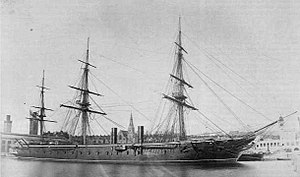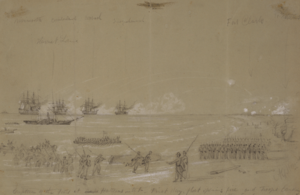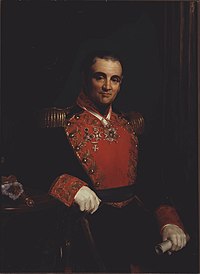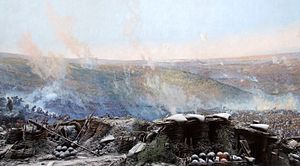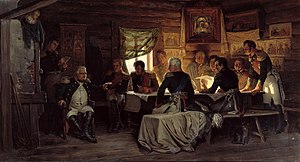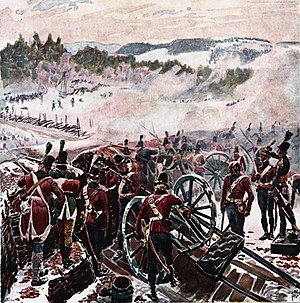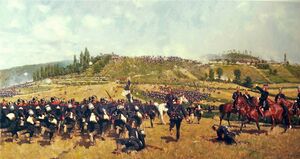Carlosian War
| The Carlosian War | |||||||||
|---|---|---|---|---|---|---|---|---|---|
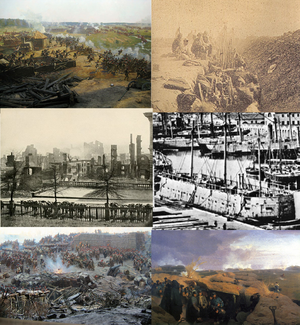 Clockwise from Top Right: Treleini soldiers entrenched outside the city of Matanzas, a Valden ironcland under construction in Roslinburg, the Valian Expeditionary Brigade near Leeds, the 52nd Del Marva Regiment at the battle of Fort Naranja, the Ruins of Weissburg after the evacuation and looting of the city, The Verdean 10th Regiment of Regulars at the battle of Regenstadt Heights. | |||||||||
| |||||||||
| Belligerents | |||||||||
|
| ||||||||
| Commanders and leaders | |||||||||
| Strength | |||||||||
|
Initial Strength
Total Manpower 11,785,934 |
Initial Strength
Total Manpower | ||||||||
| Casualties and losses | |||||||||
|
13,000,515
|
8,667,168
| ||||||||
| Triple Pact statistics do not consider civilian losses in their casualty statistics; modern estimates place the number of civilian deaths of Triple Pact nations in the Carlosian War at roughly 1.71 million. | |||||||||
This article is incomplete because it is pending further input from participants, or it is a work-in-progress by one author. Please comment on this article's talk page to share your input, comments and questions. Note: To contribute to this article, you may need to seek help from the author(s) of this page. |
The Carlosian War (Verdean La Guerra de Emperador Carlos, Isarléan Le Guerre d'Empereur Charles, Valdens Der Karlkrieg), also known as the First Meridonian Great War, was a seven year and one month long war fought between the Isarlo-Verdean Alliance, led by the Second Verdean Empire and the Triple Pact of Trelein, Valden, and Sumaaväa, over several territories along the coastline of eastern Meridon, most notably, the provinces of San Lumen, and Roslinburg, which were historically Verdean colonies taken over by the mainland powers during the Imperial Period, but that the First Verdean Empire, and successor regimes never ceded claim to. The conflict was immediately sparked by the sabre-rattling declaration of intent to retake lost territories, made by Verdean Emperor Carlos XII Parisa, and the subsequent invasion of Treleini San Lumen.
On May 6th, 1865 (23 de Mesjandra, DI 65 in the Verdean Calendar), The Verdean Imperial Navy formally declared war on the Divine Imperium of Trelein, preparing an invasion of San Lumen twenty days later. The Verdeans unleashed a number of secret weapons during the opening phases of the war, devastating the outdated Treleini military, and quickly seizing victory over Trelein over the course of a few months.
The Verdean Empire subsequently invaded Valden which proved a more lasting conflict; with campaigning in Valden proper lasting nearly three years, before the capital; Weissburg was seized. The Valdens however, refused to surrender, even as the Verdeans launched their ill fated first invasion of Borealés del Norte, then the Sumaaväan capital of Viime Satama. Coupled with the re-entry of Trelein into the war with their new puppet state of Los Cuarzos, as well as the alliance between Isarlé and Verde the war entered it's second phase; as the two alliances fought the bloodiest battles of the war.
The turning point of the war ultimately came with the disastrous failure of the second invasion of Sumaaväa, and the near complete destruction of the entire army sent to take Viime Satama; with the collapse of that front, and the freeing up of Sumaaväan reserves; 1870 and 1871 saw the complete collapse of the fronts in mainland Meridon, and exit of Isarlé and the Vale from the War; and after the campaign to liberate Los Cuarzos; the death of Emperor Carlos XII, and some campaigning in the Verdean Archipelago proper, the war was end by an armistice on the 31st of December (52 de Mesvacío; Verdean Time) of 1871 (DI 71), with the conflict formally coming to a conclusion with the Treaty of Corazón del Río the following year.
The Carlosian War saw the dramatic re-balancing of power in Meridon; with the Verdeans permanently losing their claims to the Mainland, and losing power and influence more generally; seeing the modernization Trelein, paving the way for Capisarian re-unification a few decades later; and establishing Valden became the preeminent continental power until the end of the Valden War in the 1930s.
Causes
The causes of the Carlosian War were rooted firmly in the slow decline of the First Verdean Empire during the Imperial Period, the birth of Nationalism, and growing anxiety about the loss of influence and economic might to the mainland powers. The newly crowned Emperor of the Second Empire, promised a restoration of Verdean power and glory, by seizing historically claimed territories, occupied by mainland powers, and humiliating and weakening said powers, thus re-establishing Verdean hegemony over the entirety of Greater Meridon. On the other side, a number of the Triple Pact powers were among the ascendant Meridonian nations, with the Valdens in particular seeking establish themselves as a major regional power after their empire broke up in the Liberal Revolutions of the late 18th century; and the Divine Imperium of Trelein, as well as the Republic of Isarlé which were in conflict over the nature of Capisarian culture, and both sought, to some extent the re-establishment of the Capisarian Empire. The growth of nationalist sentiment in many of the warring nations made a major conflict in Meridon largely inevitable in the eyes of contemporary and modern scholars, and re-establishment of the Verdean Monarchy by such a militant personality as Carlos XII was simply the spark to start the conflict.
Prelude
The fall of the Imperial Administration in the Verdean Revolution, led to the short lived Verdean First Republic. The Imperial colony of Los Cuarzos seceded shortly afterwards, forming the Cuarzan Confederacy, a move which the Republic, still in chaos, could not react to. Over the next few decades, the Republic struggled to maintain a balance of power between the various factions of Verde, with growing instability resulting in the end of democracy with the election of the Unity Party, and the establishment of the year long Directorate, whose brutality and corruption led to the "Quiet Coup" of Carlos Parisa, a young military officer in 1850 (DI 50), and the establishment of the Second Verdean Empire.
The newly crowned Emperor Carlos XII, upon coming to power promised a restoration of Verdean glory, and the re-establishment of Verdean hegemony over the whole of Greater Meridon, immediately embarking on a campaign of military re-armament, reorganization and modernization. Many Meridonian nations responded with concern; with Isarlé in particular worrying for the future of peace in Meridon. Nations such as Valden on the other hand, saw Verdean saber rattling as a chance to similarly build up military strength, with the resulting industrial boom rapidly building up armaments production throughout the region, as well as increasing the strength of standing armies. The Treleinis on the other hand refused to modernize their army, believing that their strength would come through faith rather than technology.
Carlos XII established the first modern system of conscription in 1853, replacing the outmoded model of levying as a means of mass recruitment. Similarly a major naval rearmament program commenced with dozens of new steamships replacing the sailing ships of the standing Republican Navy, culminating with the commissioning of the new flagship Corazón del Río, a 150 gun super battleship of the line. Similarly, the reorganization of the Verdean Army was completed, along with new tactics and strategies developed during the intervening years. All of which were in preparation for the first act of aggression made by Carlos Parisa.
The Verdean Empire would have a chance to test out its new model military when in 1859 (DI 59), the Second Empire invaded the Cuarzan Confederacy, and overpowered the much smaller nation with little effort. The invasion was met with condemnation by many Meridonian nations, however, few were willing to push their objection beyond words, even as the Cuarzan government fled to Trelein with the intent to someday reclaim their homeland. The invasion did, however cause Sumaaväa, and other Meridonian nations to better prepare for war.
After the Verdean Invasion of Los Cuarzos, the Imperial Military underwent further modernizations integrating new technologies notably early bolt-action, and tubular magazine, rifles, steel breech loading cannon, as well as secretly completing the Bestio Ferro class of ironclad warships, which were never before seen in Meridon. Changes to tactics also followed the invasion, as well as updates to mobilization time tables, and transport plans to maximize speed of mobilization. Similar developments would occur among the Valdens, though not to the same extent.
The final prelude to war came in early 1865 (DI 65), when Carlos XII made his famous "Verde Irredenta" declaration, essentially stating his will to press the Imperial claim to its lost colonies. The Isarléans made a desperate attempt to seek a peaceful resolution to the conflict. The Verdeans would make limited overtures to peacefully annex the territories, even as they secretly mobilized their army, and prepared for the invasion of San Lumen. As these offers would be flatly rejected, which was expected, final preparations for war were made.
Opposing Forces
The Isarlo-Verdean Alliance
Before the war, the Verdean Imperial Navy was the preeminent military force in Greater Meridon, with several ironclads, modernized artillery, a fleet over two hundred strong, and the largest effective warship in the region, the Corazón del Río. Working closely with the Navy, the Imperial Marines was similarly a formidable force, standing over one hundred thousand strong well trained, and equipped with early models of bolt-action, tube magazine rifles, as well as modern artillery, and led by several capable commanders, most notably General del Mar Luciano Ruíz Contreras. The army was the largest force in the Verdean military, standing at roughly three hundred thousand strong, with vast reserves, equipped with fairly modern equipment. At the outbreak of the war, the Verdean Empire maintained the strongest single military force in Greater Meridon, and among its best led.
Isarlé's peacetime army was comparatively small, professional force backed by a pool of conscripted reservists having replaced traditional levée systems with conscription shortly after its adoption by the Second Empire. The new conscription system was not, however, tested by conflict, and mobilization timetables and standing orders were lacking, meaning that the professional force would have to wait for an extensive period of time before reservists could assist them in the defense of the nation. They were however, fairly well equipped with modern weapons, and often supported with training from experienced foreign officers. The Isarléan Navy was fairly sizable, but dwarfed by its ally in this respect, possessing several dozen steamships. Isarlé also maintained an alliance with the Crowned Republic of The Vale, though the Valian military was quite small, and they sent only a single Brigade to fight in the Carlosian War under the command of Isarléan generals.
The Triple Pact
The Valden Royal Army was, before the war, the largest mostly professional land army in Meridon standing at a little over three hundred thousand strong. A small cadre of experienced officers and NCOs, veterans of long completed wars, and bold, well educated officers managed to maintain a solid training regime, as well as establishing the first modern general staff system in Greater Meridon twenty years before the outbreak of the war, which was an inspiration for Verdean and Isarléan militaries before and during the war respectively. It was similarly well equipped with modern rifles and artillery. The Valden Navy was somewhat neglected by comparison, though having a general staff, who frequently pushed for modernization, the Prince was reluctant to shift efforts from the Army to the Navy for a proper modernization, as a result, the Valdens were still largely reliant on sailing ships with older guns, supplemented by a limited number of modern steamships.
The Divine Imperium of Trelein was badly outdated before the outbreak of the war, relying heavily on what was essentially the feudal levying system to maintain the army's strength. The army, standing at fifty thousand before the outbreak of the war was equipped with largely with older rifle muskets, with no modern artillery to speak of. The levies which were significantly larger, having a mobilization pool of almost half a million, relied on even older technology. Training was also lacking in the Divine Imperium, with religious indoctrination taking greater import than tactical drill in many training centers. The Navy was likewise outdated, but large, relying on a vast fleet of sailing frigates, and a few ships of the line. It is widely believed that the inadequacies of the Treleini armed forces contributed significantly to their rapid defeat at the hands of the Verdeans in the campaign season of 1865 (DI 65).
Sumaaväa's military was comparatively small, being a solely professional force in peacetime. Due to the relatively small industrial base of the Republic of Sumaaväa, modern equipment was somewhat uncommon. This was compensated for by the skill of Sumaaväan leadership, and innovative tactics developed by the high command specifically to defend their nation from incursion by much larger nations. The Sumaaväan army was also supplemented by a large National Guard, similar to conscripted reserves or levies from other nations which could be mobilized and integrated into the Army command fairly quickly in the event of invasion. Similar to the Army, the Sumaaväan Navy was comparatively small and somewhat behind the cutting edge, Sumaaväan vessels on the other hand were extremely well adapted to fighting in the often frozen waters of their home territory, much better so than the nations from warmer climates.
The Invasion of San Lumen
Shortly after the "Verde Irredenta" declaration, Verdean military forces began secretly mobilizing and staging for an invasion of the Meridonian continent. At the same time overtures were made to annex the claimed territories peacefully, all of which were rejected. Trelein in particular was firm in its rejection, slighting the Verdean ambassadors making the attempt. In response to the Treleini rejection of the Verdean ultimatum, the Verdean Second Empire declared war on the Divine Imperium of Trelein on the 6th of May, 1865 (23 de Mesjandra, DI 65). At this time, invasion preparations were finalized and the assembled fleets set out to take the province of San Lumen. It would however, take a few weeks for the invasion force to arrive in the San Lumen region, giving the Treleinis valuable time to reinforce their positions in the area with troops mobilized from the territorial levies.
The Imperial Navy would clash with the Treleini fleet outside San Lumen on the 26th of May (43 de Mesjandra). The unveiling of Imperial ironclads and overwhelming force proved utterly devastating to the Treleini fleet, forcing them to rout after taking heavy losses. The Treleinis did however manage to single out and damage the Corazón del Río forcing it to retreat from the theater for several months. By day's end however, the way was clear for the ground invasion, and two days later the Verdean Marines landed just south of San Lumen. Over the 28th and 29th (45th and 46th de Mesjandra), the Verdean invaders swiftly crushed Treleini resistance in the city of San Lumen, forcing the defenders to surrender or else withdraw to defensive lines in the countryside.
Over the course of the summer of 1865 (DI 65), the Imperial Army delivered a disastrous and humiliating defeat at the battle of Corrido del Toro where the Treleinis lost nearly a third of their fielded army before successfully evacuating. They did however manage to hold their ground at the Battle of Richmond, turning the Imperials back with their fortifications in the area around Richmond. The Imperials would however, withdraw in good order, and circumvent the fortifications; forcing an engagement in the open, over seven days in early and mid July (Mestor), breaking the Treleni Army and forcing them to retret into Englen. Though the Divine Imperium would launch a counter-attack, their defeat at the Battle of Willemshire resulted in the Yugal Council forcing Olrich II to sue for peace, ceding the province of San Lumen in the Treaty of Richmond; Olrich himself was removed from office shortly thereafter.
The Isarléans pressured the Verdeans into establishing a quasi-autonomous, Republican provincial government shortly after the Treaty was signed, with the Sun Lumen Provincial government meeting for the first time on the 16th of September (51 de Meseva). The Verdeans however, had a light hand in overseeing this government, rapidly building up military presence in the area instead. Having secured a quick victory, the Verdeans were emboldened to retake their second lost province in Roslinburg, and plans to invade the province were pushed up to early 1866.
The Valden Campaigns
The Invasion of Roslinburg
In the early morning of 24th February 1866 (2 de Mesorge DI 66), a small contingent of Verdean Marines raided and destroyed coastal artillery batteries surrounding Roslinburg, an action which was followed up by the swift destruction of Valden fleet guarding the port of Roslinburg, and landing of Verdean soldiers in the city. Throughout the day, Verdean soldiers clashed with the remaining Valden defenders, but were unable to do so by nightfall resulting in sporadic fighting within the city throughout the night. The formal declaration of war would come at 22:00 that night, as both Verdean and Valden reinforcements began to arrive in close proximity to the city. The next day, the reinforcing forces met outside the city proper in the Battle of Roslinburg, resulting in a significant Verdean defeat, and the Imperial Army forces retreating into the city, as the Valdens laid siege to Roslinburg.
Over the course of the next three weeks, the Valden Army attempted to break the Verdean forces holding the city of Roslinburg, which was outnumbered, and after a naval counter-attack a week into the siege, cut off from resupply. The Valdens themselves brought in tens of thousands of mobilized reservists to continue applying pressure to the besieged Verdeans, who were driven slowly back towards the port of Roslinburg. An Imperial relief force arrived on the 16th of March (23 de Mesorge) however, and in spite of a final Valden counter-attack, successfully relieved the defenders on the following day. The Valden Army withdrew in bad order, after taking significant casualties; and was incapable of defending against incursion attempts outside the city proper before they joined with another Valden Army staging further north.
Verdean troops continued to arrive in Roslinburg, fortifying the city against further attacks, and reconstructing the port, which had taken severe damage in the fighting for the city. Smaller raiding parties were also dispatched into the countryside to secure forage, and to probe for Valden resistance. When one of these raiding parties was eliminated with no survivors in a skirmish with advancing elements of the Valden Army just north of Regenstadt, a larger Imperial Army was sent to fortify the Regenstadt Heights, hills overlooking Roslinburg and Regenstadt. A very large Valden Army assaulted these fortifications on the heights on the 2nd of April (40 de Mesorge), using artillery to blow open holes in the line and overwhelming the defenders, nearly overrunning the entire defensive line. Only the timely arrival of Imperial Reserves, including several regiments of Imperial Regular troops managed to stem the Valden advance and repulse the assaults over the course of two further days of bloody fighting. Offers from the Second Empire of peace, made after the battle were flatly rejected, forcing Carlos XII to plan for a more ambitious campaign to seize the Valden capital of Weissburg.
Campaigning in 1866
After the Battle of Regenstadt Heights, the Verdean Army advanced northward towards the River Edelweiss. The Valden Army in the area withdrew before the advance, with some units breaking off and harassing the Verdeans, raising irregular units, and slowing the advance of the Verdeans while the main body of their army retreated towards a Valden force preparing for a counteroffensive North of the Edelweiss. The Verdean Army, exhausted and under-strength from the summer's campaign encamped for the winter outside of Grunfeld. The Valdens however, were preparing for a winter counteroffensive, and as the Verdean offensive stalled, the Valdens were gathering the rest of their reserves, and readying troops for the counteroffensive.
In secret, the Valdens had delayed the attack in order to train artillerists on a new weapon they had developed, the Drehkanon or Rotary Cannon, an automatic weapon that may have proved devastating in combat. Throughout the summer campaigning season Valden regulars held North of Weissburg trained on the new weapon under heavy guard, secrecy was maintained even among the Valden Army. Delays in the manufacture of the ammunition necessary to use the Drehkanonen, resulted in the pushing back of the day of attack, and later the decision to commence without them.
Starting on the 23rd of December (44 de Mesvacío), Valden troops began crossing the River Edelweiss under the cover of darkness attempting to mask their movements toward the Verdean encampment a mere 50 kilometers south of Weissburg. In the early morning the 25th of December (46 de Mesvacío), the Valden Army launched a surprising attack on the Verdeans at Grunfeld who were quickly overrun by the fierce and massive attack, and forced into a panicked retreat while hotly pursued by the Valden cavalry. The Valdens successfully manage to chase the Verdeans to the sea before Verdean reinforcements and naval gunfire from Verdean warships managed to slow their advance. However, substantial losses and declining morale convinced Verdean General José López del Marva to retreat to more defensible highlands to the South.
The Winter Retreat and the Fourteen Days Battles
Throughout the winter months of 1867 (DI 67), the Verdean Army would engage in a fighting retreat southward, as they attempted to lure the Valden Army to a defensive line being erected on heights between the towns of Kolinburg and Triessfeld. Over the course of January, February, and March (Mesjula and Mesorge), the steady advance and frequent skirmishes began to wear down both armies. The Valdens however, were more significantly impacted by this, and attempted to cut off the line of retreat for the Verdeans by using their cavalry to cut the rail-line that had been used as the axis of retreat. They were met by Verdean Engineers in the Battle of Schwarzekaff, where the two forces clashed inconclusively for several days until the main Verdean Army arrived, forcing the Valdens to retreat.
The Verdeans would halt their retreat and stand to engage the Valdens along the Kolinburg-Triessfeld line. The Valdens launched their attack on the 3rd of March (10 de Mesorge), the initial frontal assaults are repulsed easily by the Verdean defenders. As the Valdens continued the attack however, two major flanking attempts occurred a few days later nearly broke the line. At the Battle of Kolinburg, sixty thousand Valden cavalry, and fifty six thousand Verdean Cavalry clashed in the largest cavalry battle in Meridonian history, with the Valdens narrowly repulsed. On the other side of the line, the Verdeans were pushed off the heights at the Battle of Triessfeld. Reserves pulled from the center managed to contain the breakout from Triessfeld, however a Valden attack down the center nearly breaks the line, with several days of bitter close quarters fighting resulting in slow Valden gains at tremendous cost.
The timely arrival of Verdean reinforcements from Roslinburg allowed the Verdeans to regain the initiative, and over the next few days, the Verdeans began to push the Valdens out of the defensive line. Further attacks by the Valdens, attempting to retake the initiative would occur; mounting casualties however would result in the Valden commander calling off the attack, and retreating to lower rises just north and east of Kolinburg awaiting a Verdean counter-attack. The Verdeans, exhausted by the previous fourteen days of fighting, failed to follow through with a proper counter attack, allowing the Valdens to withdraw in good order the next day. The Verdeans reinforced their line, awaiting fresh supplies and reinforcements for the start of the summer campaigning season.
The Summer Campaign of 1867
The Valdens would attempt to regain the initiative at the start of the 1867 (DI 67) summer campaigning season, by moving around defensive lines established at Kolinburg-Triessfeld, and the Regenstadt Heights, to directly assault the city of Roslinburg. Verdean reconnaissance elements did succesffuly report on the movement of the Valden Army, allowing the Verdeans to assemble a defensive force in time to block the Valden offensive. The two forces clash on the 4th of May (21 de Mesjandra), at the Battle of Rövershagen, where the Valden assault would be stalled for a day before the Valden Army would fall back, pursued by Verdean Cavalry for ten days, before they re-establish a defensive position on the Ützi Heights. The main body of the Imperial Army in the region arrives, attacking them at the Battle of Ützi Heights, where after a poorly executed assault, that was easily repulsed by the Valden defenders, on the first day; heavy Verdean artillery arrived, destroying Valden defensive positions and allowing for the follow-up assault to knock the defenders off the heights. After Ützi Heights, the Valden Army in the region broke into its constituent corps to engage in harassment attacks after the Verdeans established strong defensive positions on the western perimeter of Roslinburg.
After Ützi Heights, the Verdean Army launched its own offensive towards Weissburg. Over the first three weeks, the Verdeans encounter no resistance as they advance, with even the usual irregular harassment absent. The Valden Army in the North had chosen to retreat towards the Edelweiss to rendezvous artillery regiments trained in the use of the Drehkanonen, which were, at that point, ready to fight. As the Verdeans began to overtake the retreating Valden Army, the Valdens detached a blocking force to slow down their pursuers. The blocking force attempted to stand and stall the Verdeans at the June 20th (15 de Mestor) Battle of Frühlingfeld. Though they had to give up the field of battle, the Valdens had successfully managed to slow the Verdean Army down long enough for the Valden Army to join with Drehkanonen Regiments 60 kilometers north at Nordkaff. As Verdean cavalry pursued the blocking force, they came into contact with the main Valden Army, and after a brief skirmish at Mitte, retreated towards the main Verdean Army, reporting the Valden positions. A few days later on the 1st of July (26 de Mestor), the Verdeans attacked the Valdens encamped in the hills north of Nordkaff. Over the first two days the Verdeans slowly pushed the Valden flanks back, pushing from one hill to another, and it was thought, forcing the Valdens to weaken their center. On the third day, General José López del Marva launched a major frontal assault from Nordkaff itself with the largely Regular Second Corps of his Army. It was at this point that the Valdens unveiled their rotary cannons, which combined with canister shot from traditional artillery and volley fire from Valden rifles, forced the Verdeans back with massive losses, leaving 2,156 Verdeans left dead on the field. The Verdeans retreated from Nordkaff the following day, the Valdens were slow to pursue, recuperating for two days, but eventually advancing to the South as the Verdeans retreated. After Nordkaff, General del Marva was relieved of command by Emperor Carlos XII, and replaced with General Antonio Cruzado de Elena, the architect of the invasion of Los Cuarzos, and a corps commander during the invasion of San Lumen.
The Valdens and Verdeans fought several skirmishes as the Verdean Army once again retreated towards the coast. As the Verdeans reached the coast, they began to engage more directly with the Valden Army, stalling the Valden advance at the Battle of Kremmen. As further reinforcements arrived, the Verdeans launched a counter-attack at the Battle of Der Gelb Kaffen, overrunning Valden positions, and even capturing two Valden rotary cannons, which the crews had not managed to successfully destroy. Over the next couple of months, the Verdeans, once again on the offensive pursued the Valdens, specifically attempting to capture and destroy as much of the Valden artillery as was possible. The Valdens retreated towards Grunfeld, near the outskirts of Weissburg proper, chasing off Verdean Cavalry sent to disrupt Valden lines of supply and communication, and breaking off blocking forces to slow the advance of the Verdean Army. As the autumn came to Valden, the campaign slowed, with Verdeans ceasing offensive operations in late October (mid-Mesisa) to establish winter camp near Nordkaff. Skirmishes would continue through the winter, but both the Valden and Verdean armies were exhausted, and unable to prosecute major operations.
The Weissburg Campaign
Over the winter of 1867-68 (DI 67-68), the geopolitical situation in Eastern Meridon became increasingly unstable. Valden Grand Prince Hildebert Udo Gwerde made diplomatic overtures to other nations in the the region in an attempt to open another front in the war. In particular, Valden experts and weaponsmiths were responsible for the the overhaul of the Treleini Army. Further, Carlos XII pressured the Verdean General Staff to prepare for further invasions in Sumaaväa and Davidos. The General Staff, as a result was pressured to end the war in Valden as quickly as possible, so that the Verdean Empire could avoid fighting a war on multiple fronts. It was decided that a lightning campaign to take Weissburg would be the most likely means of knocking out the Valden government, and forcing a favorable peace treaty. General de Elena was given the task of seizing the city by the 30th of March (38de Mesorge), which required rushed planning. The Valdens on the other hand were fortifying their encampment preparing for another frontal assault against their positions, as was expected from the Verdeans under the previous Verdean General José del Marva.
After de Elena secretly transported an extra fifty thousand soldiers to the Weissburg front, he launched his initial attacks on the Valdens encamped at Grunfeld, using small probing attacks to convince the Valdens that the Verdean Army would launch another frontal attack. His main thrust however, would come at the left flank of the Valden line, which bent, and then broke forcing the Valdens into a retreat, and starting properly the Weissburg campaign. As the Valdens retreated General de Elena repeatedly engaged the Valden rearguard as aggressively as possible in order to keep the Valdens from establishing another defensive line. Simultaneously Verdean cavalry blocked Valden retreat towards the city of Weissburg itself, while also cutting lines of communication and supply into the city. The push comes to an end as the Valden Army retreats over the River Edelweiss a day's march away from Weissburg itself. The Verdeans are in hot pursuit, but are running low on supplies; de Elena realized he needed a decisive victory soon, and prepared to engage the Valdens near the village of Kramerhof.
The Verdean Army launched the final attack of the Weissburg Campaign on the 14th of March (22 de Mesorge) at the Battle of Kramerhof. Though the initial Verdean advance was stymied by the presence of Valden rotary cannons, as ammunition supplies started to run short for the automatic weapons, the Verdeans began to more successfully apply pressure to the Valden line. However, intense fighting continued throughout the day until at fifteen hundred hours, several brigades of regulars, and a regiment of Imperial Marines launched a bayonet charge against the right flank of the Valden line after running out of ammunition. This attack led by General de Elena itself, broke through the Valden lines within an hour, and at high cost, forced the Valden Army from the battlefield. Attempts to cut the Valdens off from Weissburg failed however, when the Valden Army broke through a cordon of Verdean cavalry and retreated into Weissburg after suffering severe casualties.
The Valdens though still in control of their capital, were in an impossible position. Unaware of the acute shortages of supplies among the Verdean ranks, and believing the Verdean Army capable of besieging the city, the Valden general staff believed it would be wiser to evacuate the city still able to prosecute the war, rather than risk the capture of the general staff, the Valden government, and the bulk of their army in a protracted siege. As a result, the Valden army, general staff, and government evacuate the city by rail under the cover of darkness. In the evacuation intelligence documents, and ammunition stores that could not be taken in the retreat were destroyed; and munitions factories and other key armaments infrastructure are sabotaged by the retreating Valdens to ensure that the Verdeans would not receive anything of strategic value from taking the city.
The Verdeans enter the city of Weissburg unopposed, on the 15th of March, 1868 (23 de Mesorge DI 68), finding it bereft of wartime industry and ammunition supplies. However, the food stores of the city were left undamaged by Valdens. What followed was the sack of the city by the half starving Verdean Army, who looted almost all of the food in the city; often taking it from the pantries of citizens, as well as robbing the citizenry of Weissburg of many of their valuables. Resistance was frequently met with the murder of the resistant citizens. This event, known as the Rape of Weissburg was covered up with the arrest and detention of almost all journalists in the city by General de Elena, who made a failed attempt to reign in the chaos, and wanted to prevent the actions of the Verdean Army from causing severe geopolitical consequences.
The Isarlo-Treleini Border Campaign
Diplomatic Overtures
Throughout the campaigns of 1866-1867 (DI 66-67), the Valdens sought allies that could conceivably open a second front in the war against the Verdeans. The Treleinis, embittered by their defeat in 1865 (DI 65) and the humiliating Treaty of Richmond were targeted first among these. The new Valden leadership under reformers such as Thomas Windham, and the Treleini Chief of State, General Jackson Sunderson was desperate for technology and expertise to modernize their military. The Valdens provided several officers and other experts to assist in Treleini modernization attempts. The Valdens hoped that they would be able to leverage their aid into support for their own war effort. Throughout 1867 (DI 67), the Treleini Army would undergo a massive reorganization effort, while Valden advisors pushed for a more aggressive foreign policy amongst the Treleini leadership. This message would find ears easily amongst the Treleini Yugals and Generals, for whom Revanchist sentiments were widespread, and who began to plan an continuation of their previous war with the Verdean Empire.
The Verdeans would similarly seek allies on the continent, in an effort to both shorten their lines of supply, and to secure the vulnerable territories of San Lumen and Roslinburg from surprise attack. Carlos XII would turn to the Isarléans for assistance, as they had long been allies of previous Verdean regimes, and were perfectly situated to assist in the fighting against the Valdens. In the early phases of the war, Verdean diplomats attempted to secure access to Isarléan ports, but were turned down. As Trelein modernized, and became increasingly belligerent, Isarlé's leadership became worried about the possibility of a Treleini invasion, and started granting Verdean proposals, including access to ports, production of ships for the Verdean Navy, and other treaties, leading to the signing of a Pact of Mutual Defense on the 5th of April (43 de Mesorge).
The path towards Treleini re-entry into the war began when on February 17th (48 de Mesjula) the government in exile of the Cuarzan Confederacy, after several years of pressuring from the Treleini government, converted to Diternalism; to which the Treleinis responded by guaranteeing the independence of the Cuarzan State. This declaration resulted in the pushing forward of Verdean battle plans, including the Weissburg Campaign, and the diplomatic efforts to ally with Isarlé. The seizure of Weissburg very nearly ended the war, however, Valden refusal to surrender emboldened the Treleinis. With news of the disastrous Verdean defeat on the coast of Sumaaväa, the Treleinis announced their intention to press the Cuarzan question, and reclaim San Lumen, through war. The Isarléans honored their Defense Pact and declared war on the Treleinis into the conflict, and being declared war upon by Valden. The Crowned Republic of the Vale honored their own Defense Treaty with Isarlé, but were tied down in Northwest Meridon and could only provide token support in the form of an expeditionary brigade.
Treleini Incursion
Trelein, shortly after declaring war against the Isarléans and Verdeans launched probing attacks into Isarlé and into the province of San Lumen. Though quickly rebuffed by Isarléan and Verdean forces in the region, the superior performance of the Treleini Army in the field was cause for concern in the Verdean General Staff. Trelein followed up on the initial probing attacks, 19th of July (46 de Mestor), with full scale invasions into the territories they had attacked previously. The Treleini Army attacking San Lumen was repulsed at the Second Battle of Richhmond, where after a hard day's fighting the Treleinis failed to seize the heights South of Richmond, and were forced to withdraw. On the Isarléan border however, the Treleini Army had more success, breaking through the Isarléan border defenses and reinforcing their bridgeheads with reserves mobilized far faster than Verdean or Isarléan planners had accounted for.
After their initial incursion, the Treleinis continued to push into Isarléan territory, with the Isarléans only able to delay the invaders while their own army slowly mobilized. Further attacks would continue against the Verdeans in San Lumen, but were repulsed at the Third Battle of Richmond on the 28th-30th of August (32-34 de Meseva), the Battle of Berwick on the 15th of September (49 de Meseva), and the Battle of Leicester on the 1st of October (12 de Mesisa), before ceasing their offensive operations around San Lumen. The last major offensive the Treleinis would launch in 1868 would fall upon the small city of Libreville on Hennessy. Isarléan defenses in the area were limited, and as a result the Treleinis took the city with little effort, and unleashed a wave of looting and killing upon the city, most notably executing the Libreville's leadership and displaying their decapitated heads in front of the primary government building. Though driven out, a few days after taking it, the Treleinis had inflicted lasted damage on Libreville on Hennesy, which would go into a state of decline for the rest of the war and afterwards.
Starting in November (Mesisa-Mesvacío), the Treleinis, with some Verdean support had finally mobilized and staged enough troops to launch a counter-offensive into Treleini occupied territory. In the span of a month, the Isarléans overran the overstretched Treleini invaders and pushed them back towards Isarléan border. Trelein would attempt to put an end to the counter offensive at the Battle of Mont Chapel, but were defeated. By the end of 1868 (DI 68) the Treleini invasion had failed, and the frontlines had been returned largely to the pre-war border between the two nations.
Isarléan Counteroffensive and Stagnation
In the spring of 1869 (DI 69), the Isarléan Army launched their own invasion of Trelein on the advice of, and with the support of the Verdean Empire. Initially attempting to seize the old Treleini capital of Englia, the Isarléans were stalled by an effective defensive posture,though the invasion progressed into Trelein. Treleini holding actions were however, taking their toll on the defenders; the initial incursion, though slowed down, was very costly for the Treleini reservists who had not been equipped with more modern weaprony, and who struggled against the better trained and equipped Isarléan Army. Unlike the previous campaigning seasons, major combat operations continued well into the winter, as the Isarléan General Staff wanted to maintain the initiative.
The offensive came to stop when on the 20th of March (51 de Mesisa), the Treleinis managed to deliver a significant defeat to the Treleinis at the Battle of Leeds, forcing the Isarléans back, and onto a defensive posture. Trelein however, was incapable of mounting a successful counter offensive before the Isarléans managed to dig into fortified positions; attempting instead to circumvent the Isarléan defenses. Over the course of the summer, flanking attempts, and counter-flanking attempts resulted in a front line steadily stretching from the mountains to the sea, each side fortifying their own positions against assault from the other side. The offensive ended with the lines some eighty kilometers south of the border, but was ultimately successful in pulling the bulk of the Treleini Army away from San Lumen towards this ever expanding front.
The Verdean Imperial Navy and Marines staged an attempt to break the stalemate by circumventing the Treleini line a with a naval landing, and therefore allowing the Isarléans to turn a flank around the Treleini defensive line. The invasion fleet was met by Treleinis at the Sea Battle of Westchester. The Treleinis unveiled their new secret weapon, the armor piercing shell, at this battle, and used it to devastating effect against the Verdean ironclads. The Verdean Navy, taking severe losses was forced to withdraw, and the surviving elements of the fleet and Marines were reassigned to the Sumaaväan Front. As a result of this failed offensive, the front would remain largely static for the next year, with major offensives replaced by intermittent raiding along the front.
The Invasion of Sumaaväa
Initial Invasions
With the recent victory in Weissburg, plans were pursued to invade Sumaaväa with the intent to secure the coast of mainlaind Meridon, and clear the way for the seizure of Davidos. Carlos XII hoped that Valdens would sign a peace treaty with their capital fallen, and the Verdean war aims achieved, and that the Imperial military could focus its full might on the Sumaaväans knocking them out in a quick surprise strike. As Verdean peace overtures were contiunally and flatly refused by the Valdens, Carlos Parisa became impatient, demanding action even as the Verdean diplomats in Valden would make yet another attempt to sue for peace. He ordered the launching of the invasion of Sumaaväa, timed a few hours after the formal declaration of war. Delays from the Imperial invasion fleet would result in the play becoming asynchronous as the Verdeans declared war nearly two weeks before the fleet would arrive, giving the Sumaaväan vital time to prepare their defense.
The Verdean Third Fleet, largely composed of older vessels, met the Sumaaväan Navy and at 20-22nd of June (15-17 de Mestor) Battle of Suomi Strait, and was delivered a major defeat by the well prepared Sumaaväans who used islands in the battlezone to engage in major sneak attacks, and destroying a large chunk of the Third Fleet. The Valdens, who were considering peace before this battle, immediately refused for the final time, sending the Verdean diplomats back to the Empire, and the Treleinis, wishing to re-enter the war and reclaim their lost territory used this defeat, and their guarantee of Cuarzan independence as a case for re-entering the war. As the war shifted southwards once more, Verdean plans for a second invasion of Sumaaväa were put off for nearly a year, as they would attempt to wrangle diplomatic support for a land invasion.
In early 1869 (DI 69), a longstanding conflict between the northern states of Falkenslovask and Nordlen was temporarily brought to an end through mediation by Verdean and Isarléan diplomats. As part of the negotiated peace, the states would allow for Verdean peacekeepers to maintain the extant border for a period of ten years. While theoretically a move to maintain peace and stability in Northern Meridon, this move was, in actuality a means of establishing basing rights to launch an overland invasion of the Republic of Sumaaväa. Over a few months one million soldiers, a "Grand Borealés Army" were moved into Nordlen for the purposes of invading Sumaaväa, launching the campaign on May 1st (16 de Mesjandra).
The Verdean Invasion of Sumaaväa initially went well for the Verdeans, with the Verdeans delivering a significant defeat to the Sumaaväan Army three days later at the Battle of Koulema. The Sumaaväan military adapted however, with the Sumaaväan units engaging in harassing attacks against the Verdean Borealés Army as they withdrew, destroying vast amounts of vital infrastructure for the Verdeans. The Verdean General Staff, frustrated with the evasive nature of the Sumaaväans, resolved to force the issue, by marching directly on the capital, and directly threatening the Sumaaväan government. Though the Sumaaväans initially refused this engagement, they were eventually forced to commit to battle as the Verdeans approached Viime Satama.
Occupation of Viime Satama
The Verdean Army successfully managed to force the Sumaaväan Army to directly engage in battle outside their capital at the end of summer. In the Battle of Viime Satama, through attrition combat, and overwhelming artillery superiority the the Verdeans did manage to deliver a defeat to the Sumaaväans, taking control of the heights overlooking Viime Satama. Though they were in a position to threaten the capital city of Sumaaväa itself, the Verdean Borealés Army was exhausted by the days fighting and unable to make the final march to take the city. Further, they were unsuccessful in destroying the Sumaaväan Army outright, and, unable to pursue them, allowed for a Sumaaväan withdrawl and the continuation of the war.
The Sumaaväans like the Valdens before them evacuated Viime Satama in order to continue the war. Unlike the Valdens however, they did destroy food stores, and evacuated much of the civilian population in addition to the government and army units in the city. Additionally, the Sumaaväan ambassador to Valden, under pressure from the Valdens and Treleinis, signed onto a semi-formal wartime alliance, agreeing to not seek a separate peace with the Verdean Empire, and formally creating the Triple Pact. The Verdeans, as a result, occupied a largely empty city. News of the occupation caused Carlos to seek peace overtures with the Sumaaväans, unaware of the their signing onto the Triple Pact, and were refused.
Over the next month and a half, the Sumaaväans would set up a blockade of Nordlen, intercepting ships coming into Nordic trade ports, this action nearly caused a war between the two nations, but Sumaaväan assurances that only Verdean ships would be intercepted and seized, prevented open hostilities between the two nations, and allowed for the continuance of the blockade which cut what limited supplies they were providing to the Verdean Army in Viime Satama, and made their situation desperate. When a mysterious fire broke out in Viime Satama, much of the city burned to the ground killing nearly twenty five hundred Verdean soldiers, and destroying much of the shelter that the Borealés Army was dependent on. General García, commander during the occupation realized that the situation was unsustainable and prepared to withdraw back to Nordlen, against the wishes of the Emperor.
Verdean Withdrawal and the Destruction of the Borealés Army
Starting in early November (late Mesisa), the Verdean Borealés Army began to withdraw from Viime Satama back towards its staging areas in Nordlen. The Sumaaväans pursued the Borealés Army, constantly engaging in harassing attacks against the poorly supplied and starving Verdeans, and preventing them from escaping by any route other than the mostly destroyed path they had taken during their invasion, killing and capturing vast swathes of the Borealés. Verdean soldiers also fell in large numbers due to frostbite, due to their poor preperation for the particularly Sumaaväan winters. As the Verdeans approached the Nordic border, they were made to fight, at Kitee and Usadishsche, being defeated easily. Finally, at the Battle of Kravtsova, Verdean soldiers recruited from San Lumen, held off Sumaaväan assaults as the ninety thosuand survivors of the Borealés Army retreated into Nordlen.
Over the course of the next few months, several attempts were made by the Isarléans and Verdeans to break through the Sumaaväan blockade. Each attempt had failed with only the Isarléan attempt on the 11th of January (11 de Mesjula) coming close to successfully break through the Verdean blockade. Even as attempts were made to break the blockade, the Verdean General Staff had realized the campaign was lost, and reinforcements were no longer forthcoming. While the Isarlo-Verdean alliance attempted to break the blockade, diplomats from the Triple Pact applied diplomatic pressure to Nordlen for the power to capture the surviving Verdean soldiers, as well as the handful of troops that were in place to actually monitor the situation between Nordlen and Falkenslovask. While they intially refused, threats of Invasion by Valden, forced the hand of the Nordic government, who demanded that the Verdeans leave Nordlen by March 11th (27 de Mesorge).
The evacuation of Nordlen would come just as the Verdeans would make one final attempt to break the blockade. The Verdean Navy did successfully manage to create an opening for the Borealés Army to escape. In an odd battle, commandeered small craft, fishing boats, and commercial ships fled from Nordlen, constantly harassed by Sumaaväan warships, even as the Verdean fleet attempted to pick up any survivors. Though several thousand Verdeans would freeze to death in the icy waters, much of the remnant would be evacuated. Those who could not commandeer ships were surrendered to the Sumaaväans after they moved in. Captured Verdeans were interrogated by the Sumaaväans before being turned over to the Treleini for further interrogation and execution. The Borealés Army, nearly a fifth of the Verdean military was effectively destroyed, with only sixty thousand fleeing to serve on other fronts.
Triple Pact Counteroffensives
The Collapse of the Northern Front
After the disastrous invasion of Sumaaväa, and the complete destruction of the Borealés Army, the Verdean Army's reserve of manpower was sorely depleted, and offensive operations were largely deemed impossible by the Verdean General Staff. Efforts were instead directed towards defending already captured territory in an attempt to seek a favorable peace and maintain the conquest of San Lumen and Roslinburg. Verdean Marines built up defensive works around several strategic positions. Weissburg in particular was heavily fortified by a series of several fortifications, the lynchpin of which, Fort Naranja was made virtually impregnable, and heavily armed with artillery, and reverse engineered rotary guns. Roslinburg, and San Lumen, at that point considered safe, were not fortified as heavily.
Valden and Summaaväan forces had knowledge of this fortification plan thanks, in large part, due to civilian informants. The Valden General Staff was however, pressured by the monarchy to take back Weissburg. Plans had to be made to retake the city, regardless of how heavily fortified it was. Leadership in the Valden and Sumaaväan Armies made preparations to break through the Verdean defenses in the city, speaking with their Triple Pact partner, General Jackson Sunderson, who agreed to launch a secondary attack along the Isarléan Front and in San Lumen to pull Isarlo-Verdean attention away from Weissburg, with the first attacks against Isarlé on 15. March. 1870 (31 de Mesorge, DI 70) being moderately successful in their aims. Though reserves were not pulled away in the numbers the Valdens would have preferred, continued pressure from the monarchy forced their hand, and plans to attack Weissburg continued with only a few days delay.
The initial Valden assault came on the 12th of April (49 de Mesorge). After an intense artillery barrage lasting throughout the early morning, several corps of the Valden Army pushed the center of the Verdean line even as Sumaavaäns applied pressure to the flanks. Though the Valdens suffered heavy casualties, the Verdean fortifications, especially Fort Naranja were heavily damaged by the intial bombardment, and its defenders were similarly battered, allowing for a major Valden breakthrough. Though the Verdeans would attempt to retake the central fortifications throughout the day, these attempts were ultimately unsuccessful. As a result, the Verdean defenses became large untenable as Valden artillerists moved artillery into these commanding positions and began to bombard the Verdean flanks. The Verdean Army withdrew to the city proper that night.
Over the course of the night Valden civilian saboteurs secretly destroyed many Verdean ammunition stores and powder magazines, dramatically reducing the supplies available to the Verdeans. The next day, the Sumaaväans and Valdens attacked Weissburg proper. Though the Sumaaväans, had an easy time taking neighboring boroughs south of the River Edelweiss. The Valdens, hampered by lack of access to artillery, due to political concerns, and facing the old Castle Weissburg struggled for much of the day. By the late afternoon however, Verdean ammunition began to run out, and the Verdeans were forced to withdraw from the city. After the Castle had been retaken, the Valden Army staged a parade through Weissburg in the evening as the Sumaaväans chased the Imperials away from the city.
During the rest of spring 1870 (DI 70), the Verdean Imperial Army retreated, constantly harrassed by Valden and Sumaaväan skirmishers and prevented from re-establishing a defensive line. The Verdean General decided to divide the Army into its constituent corps and retreat towards the Wolfbriar Mountains on the Isarléan border; and towards Roslinburg's defensive line separately. Though the Verdeans would successfully managed to re-establish defensive lines, they had lost most of the territory gained during the campaigns of 1867 and 1868, and the Valden, now free to recruit openly, swelled in size as territories in South Valden mobilized their remaining reserve regiments. Further, the Valdens were now free to apply pressure to the northern Isarléan border, and allow Trelein to launch its own major offensives.


